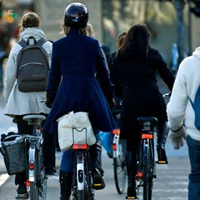Cycle Sustainability
DOI:
https://doi.org/10.6092/1970-9870/2921Keywords:
Cycling, sustainability, transportAbstract
One of the main problems that affects modern cities is connected to transport/mobility. Urban transport is currently based on car use; the transition to the use of more sustainable means of transport is happening slowly. Bicycles used as main way of transport, combined with walking, it’s a successful solution for many towns to really bring traffic and congestion down. For their high density and their short time travels, towns are the best places (in comparison to long time travels as merchandise transport) to reduce the green houses gasses emitted promoting walking, cycling and public transport. For this reason the European Union is directly founding different projects that boost urban cycling. Many examples presented in this paper where collected by an European project. This project sectioned best practices and excellences in cycling as the so called cycle cities: Amsterdam, Copenhagen, Seville,…cities that have recognized the importance of cycling as a solution to traffic congestion. But how is it possible to transfer these experiences to others realities?
The scope of this article is to show the sustainability of cycling according to socio-economic (social and economic sustainability) and environmental terms (environmental sustainability).
For this reason is proposed a CBA (Cost and Benefits Analysis) methodology specific to evidence the advantages of investments in cycling made by public authorities or private companies both, to promote and realize ecological infrastructures.
One of the main problems that affects modern cities is connected to transport/mobility. Urban transport is currently based on car use; the transition to the use of more sustainable means of transport is happening slowly. Bicycles used as main way of transport, combined with walking, it’s a successful solution for many towns to really bring traffic and congestion down. For their high density and their short time travels, towns are the best places (in comparison to long time travels as merchandise transport) to reduce the green houses gasses emitted promoting walking, cycling and public transport. For this reason the European Union is directly founding different projects that boost urban cycling. Many examples presented in this paper where collected by an European project. This project sectioned best practices and excellences in cycling as the so called cycle cities: Amsterdam, Copenhagen, Seville,…cities that have recognized the importance of cycling as a solution to traffic congestion. But how is it possible to transfer these experiences to others realities?
The scope of this article is to show the sustainability of cycling according to socio-economic (social and economic sustainability) and environmental terms (environmental sustainability).
For this reason is proposed a CBA (Cost and Benefits Analysis) methodology specific to evidence the advantages of investments in cycling made by public authorities or private companies both, to promote and realize ecological infrastructures.
Downloads
References
Akinder, M. (2010), Policy Manual for Calculating Greenhouse Gas Benefits of Global Environment Facility Transportation Projects, New York
Banister, D. (2008), The sustainability mobility paradigm, Elsevier Vol. 15, USA, Pages 73–80
Beukers, E., L. Bertolini & M. Te Brömmelstroet (2012), Why Cost Benefit Analysis is perceived as a problematic tool for assessment of transport plans: A process perspective, Elsevier Transportation Research Part A, USA, Pages 68–78
Cecchini, A., Talu, V. (2011), “Camminare (e pedalare) per trasformare la città”, TeMA Vol.4, ISSN 1970-9870
Cramer, M. (2009), Soft mobility Measures for a climate-friendly transport policy in Europe, Brussels
Department of Industrial Engineering, Mechanical Faculty, Yildiz Technical University (2009), Evaluating the environmental effects of transportation modes using an integrated methodology and an application, Istanbul
Dougherty, M. (1995), “A review of neural networks applied to transport”, Elsevier Vol. 3, USA, Pages 247–260
Ege, C., Krag, T. (2002), Cycling will improve environment and health, Copenhagen
European Commission (2009), A sustainable future for transport: towards an integrated, technology-led and user friendly system, Luxemburg
European Parliament (2012), The European Cycle Route Network Eurovelo, Challenges and Opportunities for Sustainable Tourism, Brussels
EU transport (2014), European statistical pocketbook, Belgium
Haezendonck, E. (2007), Transport Project Evaluation: Extending the Social Cost-Benefit Approach, Belgium
Institute for sensible transport (2012), Integrating cycling with public transports, Queensland, Australia
La Rocca, R. A. (2010), “Soft Mobility and Urban Transformation”, TeMA Vol.3, ISSN 1970-9870
London Borough of Merton (2014), Analysis of private investment infrastructure, Project CycleCities, UK
Mackie, P. (2010), Cost-Benefit Analysis in Transport: A UK Perspective, International Transport Forum, Mexico
May, A.D., Page, M., Hull, A. (2008), Developing a set of decision-support tools for sustainable urban transport in the UK, Transport Policy 15, UK
Mouter, M., Annema, J., & van Wee, B. (2013), Cost-Benefit Analysis in Practice, Nicis Insitute, Belgium
Municipality of Genoa, DICCA-University of Genoa (2014), Analysis of environmental aspects, enrichment of individual reports, development of synthesis report, Project CycleCities, Italy
Odgaard, T., K, C., Laird, J. (2005), Current Practice in Project Appraisal in Europe, Trafikdage Aalborg Universitet, DK
Regional Development Agency of Gorenjska - BSC, Kranj (2014), Analysis of public investment costs, inhibitors and externalities, Project CycleCities, Slovenia
Rotaris, L., Danielis, R., Marcucci, E., Massiani, J. (2010), The urban road pricing scheme to curb pollution in Milan, Italy: Description, impacts and preliminary cost-benefit analysis assessment, Elsevier Transportation Research Part A, USA, Pages 359–375.
Saelens, B.E. et al (2003), Environmental Correlates of Walking and Cycling: Findings From the Transportation, Urban Design, and Planning Literatures, Annals of behavioral medicine, USA
Tight, M. (2011), Visions for a walking and cycling focussed urban transport system, Institute for Transport Studies, University of Leeds, UK
Vickerman, R. (2000), Evaluation methodologies for transport projects in the United Kingdom, Transport Policy 7, UK
Whitelegg, J. (2008), Integrating Sustainability into the transport, Stockholm Environment Institute, University of York, UK
Zadeh, L. A. (1975), Fuzzy logic and approximate reasoning, India Statistical Instiute, India

Downloads
Published
How to Cite
Issue
Section
License


